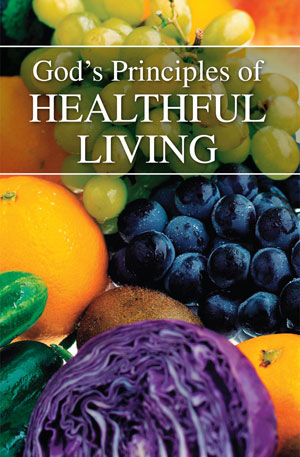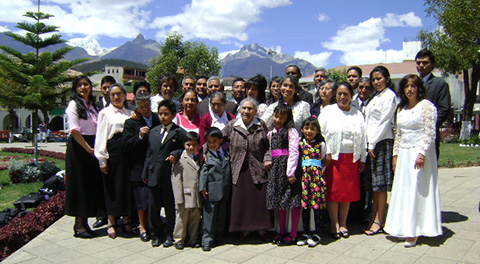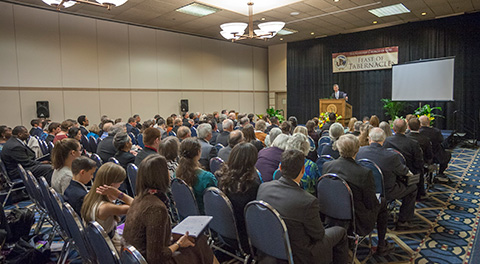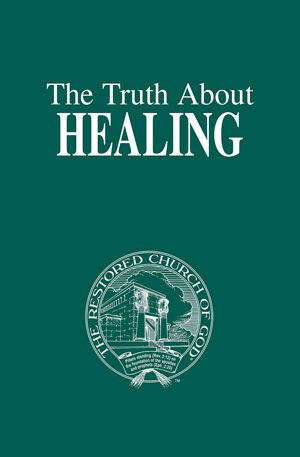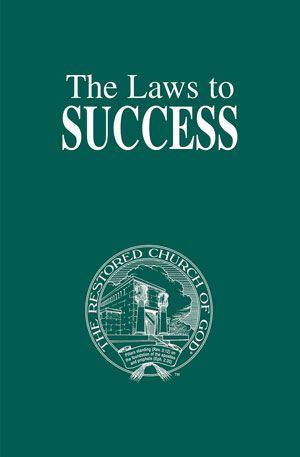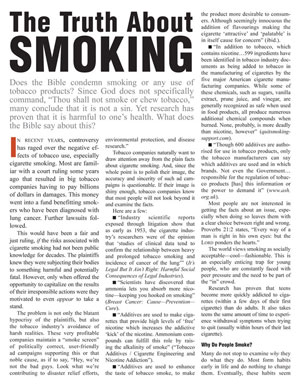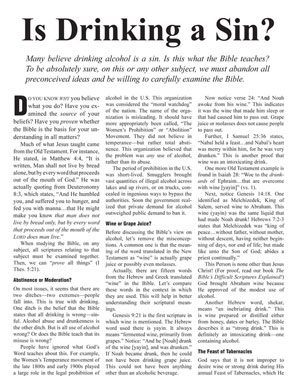God’s physical creation is governed by definite, physical laws. These include laws that regulate our bodies. To be healthy, you must follow them. But when they are broken, sickness results.
When a person breaks these principles and laws of health—whether through omission or negligence—the body suffers. Among the negative results are malnutrition, atrophy from inactivity, or exhaustion from lack of rest—simple cause and effect.
In this booklet, we will examine several factors contributing to physical well-being, and help you identify areas where improvements could be made. Some of these involve the breaking of firmly established bad habits. These must be replaced by new habits that harmonize with God’s laws of health. A mind that wants to obey God will look for ways to improve and upgrade life. This includes being more alert, awake, and alive!
Though not stated in detail in the Ten Commandments or other statutes and precepts, the physical laws of health are living laws—they are real—and the Bible addresses many of them in principle. Breaking them is physical transgression—physical sin.
Breakdown of Health
Throughout history, including the times of ancient Israel, and even in Christ’s day, eating normally available foods was, for the most part, nutritious. This is no longer true. Today, eating basic available foods results in gross nutritional deficiencies. These foods are teeming with toxins and other harmful elements!
Through technology, man now has the ability to irradiate his food supply. This involves the use of radiation to kill bacteria, primarily in fresh produce. Of even greater concern is the increasing use of genetic engineering, especially in the U.S., where labeling is not required to reveal what many consider an untested, risky and potentially devastating practice. The use of genetic engineering has now spread to include most soy, corn, and other grains and legumes, fresh produce, fish raised at fish farms, while indirectly affecting most dairy products and meats sold in the open market.
Many consider such “breakthroughs” to be infinitely more harmful than indicated by their promoters, who reap financial windfalls from such government-sanctioned enterprises. While most European, Asian and other countries have sternly rejected such tampering with their food supply, Americans give their government full reign to implement whatever course it chooses. They exalt medical science and technology above God, and willingly accept the dictates of government and science “experts.”
To restore or preserve health, you must make an effort to eat wholesome, unprocessed food as God intended.
“Going with the flow”—eating the normally accepted foodless foods found on supermarket shelves and at most restaurants—can be more dangerous than most realize. We must understand what constitutes wholesome food and where it can be found. You must also recognize the dangers of an inactive lifestyle, so common today due to a total dependence upon automobiles.
Health Questions
Healthful living extends beyond food and exercise. This booklet will answer questions such as:
Why is rest so important? How can we minimize toxins? Does hygiene matter? Do nutritional supplements help? What about herbs and the benefits of herbal remedies? These and many other questions require answers!
Perhaps you already walk a few times each week. Perhaps you already attempt to eat a balanced variety of wholesome foods. If so, this booklet will reinforce what you already practice. Most likely, even if you are already implementing most of these practices, you will gain new insight.
God does not want us to be ignorant of how cause and effect relates to healthful living. Applying these principles in a balanced way yields great benefits. Healthful living is not an end in itself. Avoid getting carried away or becoming obsessed with health—do not make it your god!
Once you know the principles that govern health, you can grow in understanding and better practice them. But this should merely be your starting point, with long-term goals in mind. The physical is temporary at best. While you can demonstrate to God that you have wisely managed these physical resources, your main goals in life must surpass the “here and now.” You must not overly focus on exercise or foods.
In this life, some suffering is necessary. God allows us to endure certain physical ailments and afflictions for a reason. Sometimes, tests come in the form of physical affliction. However, by becoming armed with certain facts and knowledge, and acting on them, you can show God your willingness to properly care for your body—“the temple of the living God” (I Cor. 3:16-17). This will lead to greater resistance and immunity to disease and sickness.
Two Concepts of Treating Disease
There are two opposing concepts of treating disease. The traditional concept of disease is not much different than voodoo. The only difference is that “evil spirits” have been replaced by evil germs, bacteria, or viruses. The traditional concept is that disease unpredictably strikes unsuspecting victims—these are things that people “catch.” The job of the modern “medicine man” is to rescue the victim by killing or driving out the evil intruders (the germ or virus) with “magic” medical power from his arsenal of needles and prescriptions.
The newer biological concept takes exception to traditional symptomatic drug therapy in treating disease. It is based upon irrefutable proof that invading bacteria or viruses are not the primary cause of disease. Rather, it is weakened resistance, brought about by health-destroying lifestyles. Bacteria enter the picture only in the later stages. They help terminate organisms lacking a strong defense against them. Strong immunity is common to all healthy organisms.
Scientists and biologists know that bacteria are always present in our environment, as well as in a dormant state in all organisms. These bacteria are almost invariably completely harmless when natural health and resistance are maintained. However, they will step in and destroy the host organism as soon as its vitality and resistance weaken or diminish.
Rather than treating the symptoms with drugs, the biological concept emphasizes finding and correcting the cause of the disease. The results are sometimes realized quickly. Other times, results take longer to appear. In a nutshell, the cause-and-effect approach has been far more successful than treating the symptoms.
Good health is a precious attribute. You must maintain it. Otherwise, it deteriorates. Traditional living habits and environments are hostile to good health. Unless you make an effort to protect and maintain it, good health could easily disappear—even at an early age. Given the correct habits and environment, the body was designed to be self-healing and naturally healthy.
PART 1: REACTIVATING YOUR BODY
What is the vital element lacking most among man’s living habits, proving detrimental to his health? Physicians and health professionals raise this issue in many forums and publications. Their answer is virtually always unanimous, and comes as a surprise to some people.
Health professionals cited inactivity as the most detrimental modern trend. Daily activity—exercise—is the solution. The body was intended to be active and liberated from the “curse of inactivity.”
Inactivity is partly attributed to TV, the automobile, assembly line or office jobs, and laziness. Many are chronically tired and simply do not feel like “re-activating their body.” All too often, life’s pressures and responsibilities seem to limit opportunities of reaching even basic goals, such as improving health. But if such people took measures to improve health, they might be in for a surprise!
Aerobic Exercise
If a pharmaceutical company sold a drug with such proven results as that of regular, sustained exercise, it would be extensively advertised on mass media and widely reported on national news. It would net the company billions of dollars.
Ironically, the idea of replacing inactivity with just a little sustained scheduled activity is simply not appealing to the public. So, many shrug off the notion of an exercise program, declaring, “I’m no marathon runner. I just don’t have time for that sort of activity.” How ironic! If these benefits came from some over-the-counter “wonder drug,” most would pay thousands of dollars for the “cure.” Yet, they would never consider walking only 10 minutes or more daily.
Listed below are some benefits of regular, sustained (continuous and uninterrupted) exercises such as walking. Other more vigorous forms of sustained exercise include running, cycling, swimming, basketball and even stationary running. They apply primarily to younger or middle-aged people already in good physical shape.
Of course, if you decide to start a vigorous exercise program after being inactive for a long time, you should: (1) Seek the advice of a physician. (2) Start out lightly and gradually increase as conditioning improves. (3) Proceed with caution.
Walking is the most practical exercise for most people—and for most schedules. Taking the time to do this for a sustained period or distance, and on a regular basis, can net tremendous benefits! Yet, most of the population is relatively inactive. Aside from work, household duties, or working in the garden, most people do not exercise.
The benefits of regularly scheduled, sustained exercise have been known and appreciated for many generations. Yet, it was a book by Kenneth Cooper, M.D., titled Aerobics, that formally documented these benefits. Aerobic exercise is primarily aimed at conditioning the heart and lungs, which distribute oxygen to the body.
Tragically, humanity now suffers a myriad of cardiac (heart) problems. Just a few generations ago, before people became so dependent on machines, this was not the case. Cardiovascular disease is now the number-one cause of death.
The human body was not created to be perpetually inactive. Aerobic exercise was intended to reintroduce a process that could rejuvenate the entire cardiovascular system. Walking at work or at home is not usually continuous over a sustained time and distance. Therefore, it is not of significant aerobic value.
In his book, Dr. Cooper summarizes inactivity: “Most of the medical symptoms caused by inactivity are well known and they are alarming. A body that isn’t used deteriorates. The lungs become inefficient, the heart grows weaker, the blood vessels less pliable, the muscles lose tone and the body generally weakens throughout, leaving it vulnerable for a whole catalog of illness and disease. Your whole system for delivering oxygen almost literally shrivels up.
“And, if you compound the felony of inactivity by smoking two packs of cigarettes a day, by eating anything in sight, and by worrying about everything else—including your health—then the only advice I can give you is to keep up the payments on your insurance, if you can get any.
“Endurance, however, is the best kind of insurance” (p. 11).
The Benefits of Conditioning
Again, walking is the most practical exercise for many. It is but one of many exercises that will yield real benefits:
• Walking increases lung efficiency, conditioning them to process more air with less effort. During exhausting work, a conditioned man may process nearly twice as much air as someone spoiled by inactivity.
• Walking increases the efficiency of the heart. Like any other muscle, it grows stronger and pumps more blood with each beat, reducing the number of beats necessary. For example, a conditioned man may have a resting heart rate 20 beats slower than someone out of shape. This saves as many as 10,000 beats in one night’s sleep.
• Walking increases the number and size of blood vessels carrying blood to body tissues.
• Walking increases total blood volume: “It produces more blood, specifically more hemoglobin which carries the oxygen, more red blood cells which carry the hemoglobin, more blood plasma which carries the red blood cells, and consequently more total volume…An average size man may increase his blood volume by nearly a quart in response to aerobic conditioning. And, of this amount, the red blood cells may increase proportionately more” (Ibid. p. 91).
• Walking improves the tone of the muscles and blood vessels, changing them from weak and flabby to strong and firm. It often reduces blood pressure.
• Walking, especially 30 minutes daily, gradually burns off fat, which is primarily stored energy.
• Walking can also completely change your outlook on life. It can help you to relax, sleep more soundly, and be able to better tolerate the stress of daily living. You will be able to accomplish more from work, while experiencing less fatigue.
In view of these benefits, what excuse is there to not better ourselves by a 10 minute-per-day walking program? For some, certain serious infirmities or afflictions could prevent them from implementing such a program. But for everyone else, the benefits greatly outweigh the inconveniences.
Most may not have a convenient, safe, or acceptable area in which to walk. Some ways to resolve this could be: (1) Walking around the perimeter of the yard, (2) walking on a treadmill, (3) alternately jogging and walking in place, or (4) cycling on a stationary bike. (5) Also consider walking or swimming at the YMCA/YWCA.
Sometimes, realizing the long-term benefits of a conditioning program takes resourcefulness. By being resourceful, you could implement a program to greatly strengthen yourself physically and mentally. But it depends upon whether you value the rewards enough to be willing to pay the price!
Exercise is Essential
Since Dr. Cooper made his findings known, research has confirmed them. Modern research has identified and isolated the specific enzymes that cause positive elevation after sustained walking or exercising. They are far more effective than mood-elevating or enhancing chemicals—and without the negative side effects.
The ideal plan begins with as little as ten minutes per day of continuous walking. This should be repeated at least four days per week (six days a week is ideal). Try to increase the time, eventually building up to 30 minutes per session.
Chances are—if you put this to the test—by the end of four months, just the difference in vitality will convince you to continue the program.
Remember, health professionals stress that walking is as essential to good health as eating. Most recommend that it be done outdoors (weather permitting), and the long-term program should build up to a thirty-minute brisk walk. If possible, even the elderly are encouraged to participate in a milder walking schedule. But regular swimming, jogging and bicycling also yield benefits.
Activity—exercise—is the missing vital element in the lives of most, who need to reactivate their physical being through exercise. Once this is addressed, more steps can be taken to upgrade and revitalize the body. And each of these steps yields worthwhile benefits.
PART 2: WHOLESOME FOOD
Daniel 1:8-16 teaches some valuable lessons about natural food. The prophet Daniel informed his captors that he could not be defiled by the unclean food and fortified wine served daily to Babylonian royalty. Understand. In this account, he was not suggesting a random test to see whether he would benefit by eating “pulse” (Hebrew: zeroa, “food that was sown”—grown naturally from the earth—vegetables, fruits, grains, and, by extension, clean meat)—natural food. He knew the benefits of eating good food. He had practiced healthy eating habits all his life. He knew that fruits cleanse, vegetables build, grains sustain and herbs help to heal.
The result: After consuming natural food and water for ten days, the faces of Daniel and his three friends appeared “fairer and fatter in flesh than all the children which did eat the portion of the king’s meat” (vs. 15).
Here, we have a test proving the superiority of natural foods as far back as the early 600s BC. This account was recorded in Scripture for a reason. The food we eat either improves our health or causes it to deteriorate. With this clear-cut example, it is difficult to understand why so many associate eating natural, wholesome foods with fanaticism.
Wholesome Food and the Pendulum Principle
People tend to overemphasize certain issues while utterly neglecting others. Most are unbalanced and go to one extreme or the other. So is the case with the application of God’s principles of health—especially the knowledge of eating wholesome foods.
Those who have rejected God’s principles of healthful living tend to cite isolated examples of “abuse” or “over-emphasis” of using natural foods as proof that the entire practice is off-balance. Many such critics subscribe to the notion that people should leave health matters entirely to medical doctors, maintaining that reliance on medications and prescriptions is more “normal” than trying to protect or maintain one’s own health by natural means. In order to protect their own weak position, they ridicule others as health fanatics. (Of course, some are.)
Society ignores God’s principles of healthful living. Although a few strive to implement them as best they can, their knowledge and practice appears to be a dying cause. These few have shunned man’s processed, artificial imitation foods. Unfortunately, the majority has unwittingly bought into man’s idea that processed food is better than natural food. Young children are conditioned to fall into this mentality by endless advertisements promoting breakfast cereals using their favorite cartoon characters, sports stars, or jingles.
Breakfast cereals are the primary means by which most young children become sugar addicts, evidenced by chronic hyperactivity. In his 1976 book, Sugar Blues, William Dufty emphasized that sugar was just as addictive as nicotine, and equally poisonous. He cited an amazing statistic showing that sugar was consumed at the average rate of 100 pounds per American every single year. That was 1976. By 1996, it had risen to an even more astonishing 152 pounds!
The advantages of consuming wholesome foods should not be difficult to understand. Today, it is no longer considered fanaticism. Overwhelming evidence and more extensive research has further strengthened the case for natural foods and healthful living.
Grains, Fruits and Vegetables
Some object to the use of whole-wheat flour products because of allergic reactions. But in recent years, many have discovered that only hybridized wheat causes allergic reactions. The original un-hybridized grain, called “spelt wheat,” has no such allergic side-effect. (Whole wheat spelt flour is now marketed in larger supermarkets and health food stores.) Here again, only where man has intervened to “improve” upon God’s creation do we find negative results.
Back in the 1800s, white flour became associated with the gourmet food of the upper class. As a result, numerous unheard-of diseases followed this trend.
Now, in the twenty-first century, scientific research has confirmed that all grains are more nutritious in their natural state, without removing the bran and the germ. No knowledgeable individual refutes these facts. Yet, in supermarkets and other food retail outlets, about 75% of bread sales consist of soft white bread made with bleached flour. The public is not acting upon the overwhelming findings of research. Bakeries continue to give the public what it wants—more foodless food—instead of what it needs.
About 20% of the bread market is composed of combinations of mostly white flour with a certain amount of bran, cracked grain, or other combinations. Such products give the impression of being a wholesome food. But they are NOT whole-wheat bread. People who are savvy about wholesome foods avoid these breads.
Many medical professionals and nutritional experts, who understand the needs of the body, consume the very finest multi-grain and sprouted spelt wheat breads. Yet, the general public ignorantly feeds on foodless white breads, relying on advertising as its basis for what foods to buy. The general public is oblivious to most health principles. Anyone who thinks for himself should not—and must not—blindly follow such habits and practices.
For those willing to swim against the current, quality health foods are now much easier to find. Whole wheat flour (or spelt whole wheat flour), and other whole grain products such as organic corn meal, organic brown rice and other natural grains, are available in the health foods section of better supermarkets. Two or three decades ago, one could only find such items at certain health foods stores or by mail order. These better grains cost slightly more, but are far superior in nutritional value—well worth the difference.
Will you feed your body more foodless foods, laden with toxins, because it is a better bargain? What appears to be the better bargain in the short run will amount to medical crises—and potentially enormous extra costs—in the long run.
Fresh vegetables grown in your own garden are also ideal for a superior diet. This is the best possible source of food. If you do not have a garden, try to buy fresh vegetables from the supermarket or farmers’ market. Sometimes at these locations, organically grown vegetables can be found. “Organically grown” implies that no pesticides or artificial fertilizers were used in growing the plants. Spot checks by the Consumer’s Union have confirmed that certified organic produce is free of the pesticides that contaminate most other produce.
Besides supplying vital nutrients, fresh fruits and vegetables and whole grains supply much needed fiber. The digestive system must have fiber to function properly. Fiber, in addition to other qualities, absorbs water and gradually releases it during the digestive process, allowing proper functioning and the better assimilation of nutrients. Unfortunately, foods supplying an abundance of fiber are almost extinct from the junk food diet that many pursue. School children reflect the dietary habits of their parents in preferring such foods as hot dogs and pizza. In many schools, as well as homes, vegetables and whole grains are “out.” Junk food is “in”!
Besides substituting whole grains in place of processed and bleached grain products, organic fresh fruits and vegetables should be preferred over those that are canned or processed, if possible.
Six Guidelines
Here are six guidelines with regard to food. They represent the overwhelming consensus of health professionals—not just a few isolated opinions.
(1) Most of your diet (preferably over 60%) should consist of foods in their natural, uncooked or lightly cooked state. Raw vegetables and fruits are superior to those that are cooked. Cooking destroys much of the nutritional value. Many vitamins are partly destroyed, minerals are leached out (if boiled) and all enzymes are destroyed by temperatures over 120° F.
Sprouting is an excellent way to eat seeds, beans and grains in the raw form. (Sprouting involves harvesting seeds at the point of germination.) Another excellent way is to eat foods such as homemade sauerkraut. Certain foods, like potatoes and yams, dried beans and peas and grains, must be cooked.
The ideal of eating more than 60% of our vegetables raw is a goal that few are able to attain. However, rather than writing this off as impractical, try to increase your daily intake of salads, sprouts and raw fruits and vegetables. You will be glad you did!
Due to requiring different digestive enzymes, raw vegetables and fruits should generally be eaten at separate times. Health professionals point out that one or two vegetables appear to be better than a mixture of four or five. Likewise, a fruit salad of two or three kinds of fruit appear to be better digested than one with five or six kinds of fruit. Due to fruit’s cleansing effect, a “one or two” combo fruit salad makes an ideal late evening snack.
(2) If possible, foods should be whole, unrefined and grown near your environment. Imported foods can contain bacteria to which your body may not be accustomed.
When natives of a region eat domestically-grown, natural, whole, unprocessed and unrefined foods, they enjoy wonderful health and long lives. When denatured, refined, processed, manmade foods (such as white sugar and white flour, and canned and processed foods) enter their diets, disease becomes rampant.
(3) Pure water, though rare, is vital to the human body. Drink a generous amount daily—some suggest one ounce of water for every two pounds of body weight (0.3 liter per 10 kilograms). Pure water for drinking and cooking should be natural water from a deep well or a mineral spring. Many health professionals recommend the drinking of distilled water because of so many unknown contaminants that affect our water supply and the unpredictable risk in buying what is labeled as “pure water.” When drinking distilled water on a regular basis, consider taking a supplement that supplies such trace minerals as would normally be found in pure water.
As mentioned, it is becoming more and more difficult to obtain uncontaminated natural water in today’s poisoned environment. Whether your water is from a well or supplied by the city, try to use a filter. Most filter systems are relatively inexpensive and are efficient—just remember to replace the inside section of the filter assembly every other month or so. Bottled water has been shown to be unreliable and inconsistent, though expensive. If you have to depend on water purchased at a store, consider purchasing it in large bottles from a reputable supplier of natural mineral spring water or distilled water.
Recent news stories have repeatedly revealed incidents of water that had been labeled and sold as “spring water” being discovered to be nothing more than tap water from municipal water systems. Laboratory tests on bottled water have yielded some amazing results as to the contents of what is sold as pure water. Here is a sampling of dangerous impurities commonly found in marketed drinking water in minute amounts: benzene, carbon tetrachloride, propyl alcohol, and wood alcohol (methanol).
(4) Milk is an excellent food. But those who are lactose-intolerant should consider avoiding it. Raw milk is far superior to pasteurized and homogenized milk. The title “nature’s most perfect food” correctly belongs to raw whole milk—a nutritional gold mine. Unfortunately, most of us have to settle for an inferior product since interest groups like the American Dairy Association, with the approval of the Food and Drug Administration (FDA), have successfully pushed raw milk off the commercial market.
An ideal way to take milk is in its soured form: as yogurt, kefir, or acidophilus milk. Goat’s milk is better than cow’s milk as human food. While cow’s milk seems to be not recommended for patients with arthritis, rheumatic disease or cancer, goat’s milk contains both anti-arthritic and anti-cancer factors. Some feel that it may be therapeutic for these conditions. Look for goat’s milk that is fresh, rather than the refined variety that is canned or powdered. Many people who are lactose intolerant can tolerate goat’s milk.
(5) Natural, raw, unprocessed honey is one of the best sweeteners available. It has miraculous nutritional and medicinal properties that have been used for healing purposes. It has been well established that most centenarians (individuals 100 years of age and above) used honey liberally in their diets. Honey can increase calcium retention in the system, help prevent nutritional anemia, and is beneficial in fighting kidney and liver disorders. It can also be therapeutic for colds and poor circulation problems.
Consider how God associated milk and honey with the bountiful blessings of the land promised to Israel: “And I am come down to deliver them out of the hand of the Egyptians, and to bring them up out of that land unto a good land and a large, unto a land flowing with milk and honey” (Ex. 3:8).
Milk and honey were ancient symbols of health and bountiful blessings. So are they today, especially in their most natural state, unprocessed by man.
(6) Another food staple to consider is vegetable oil. Health professionals recommend cold-pressed vegetable oils. Some of the favored cold-pressed oils are those from olives, sunflower seeds, sesame seeds, and canola. As a general rule, olive oil imported from Italy or Spain is usually cold-pressed. Since natural cold-pressed oils are not cooked or processed, and can eventually turn rancid, check the date on each bottle or container.
Large food processors are permitted to use strong solvents to extract oil from certain nuts and seeds. While this method is more efficient than the cold-pressed method, it leaves behind solvent residues, which are then evaporated by high temperature. (This heat kills any residual vitamins that may have survived the strong solvents.) These residues include a generous supply of free radicals that are toxic to any organism. Coping with these toxins adds additional stress to the overtaxed immune system. For these reasons, items such as mayonnaise, potato chips, and french fries laden with vegetable oil, should be avoided or greatly limited.
Many have difficulty understanding that fresh natural food can turn bad if left too long on a shelf. The reason processed foods have a longer shelf life is that only impotent carbohydrates are left behind once the nutritious parts are removed or cooked to extinction in the “refinement process.” Not much is left that is even subject to deterioration.
The Issue of Meats
The information contained in this section and the entire booklet assumes that you are familiar with God’s laws of clean and unclean meats. If not, read our free article “Are All Animals Good Food?”
The issue of hormones and antibiotics injected and fed to beef cattle has caused some to wonder if vegetarianism might be the best option after all.
But read I Timothy 4:1-3: “…in the latter times some shall depart from the faith, giving heed to…doctrines of devils [demons]…Forbidding to marry, and commanding to abstain from meats, which God has created to be received with thanksgiving of them which believe and know the truth.”
Here the practice of abstaining from (clean) meats that were created by God for food is called a doctrine of demons. The philosophies and religions promoting vegetarianism can often involve demonism, whether in certain well-known regions of the world, the U.S. or elsewhere.
Yet in this day and age, when hormones and antibiotics contaminate much of our food, the intake of such beef should be monitored. Chemical-free alternatives should be sought.
Red meat is a vital source of health benefits: Iron, zinc, magnesium, thiamine, riboflavin, vitamin A, protein, B12 (only found in meat), B6, niacin and more.
Even if you are fortunate enough to find chemical-free beef and poultry, there is a strong case in favor of eating less animal protein. The metabolism of proteins consumed in excess leaves toxic residues of metabolic wastes in the body’s tissues. When someone habitually overindulges in animal protein, a host of problems and diseases can result. In addition, a high animal protein diet causes premature aging and lower life expectancy.
Being more balanced in the amount of animal protein we consume—especially beef or lamb—is beneficial. It is better that you avoid larger “jumbo” steaks in favor of the smaller, eight-ounce cuts.
Research has shown that overindulgence in meats leads to mineral imbalances in the system. Reports show that it results in too much phosphorus in proportion to calcium. (Meat has 20 times more phosphorus than calcium.) This can lead to a severe calcium deficiency, resulting in tooth loss or pyorrhea (a gum disease).
Researchers in Germany and Switzerland have discovered that the aging process is triggered by amyloid, a byproduct of protein metabolism. Amyloid is deposited in the connective tissues and causes tissue and organ degeneration. Perhaps this explains why people who traditionally eat low animal protein diets have the highest average life expectancy in the world—90 to 100 years. This could also explain why people who live on high animal protein diets (such as Eskimos, Greenlanders, Lapplanders, Russian Kurgis-tribes, etc.) have the lowest life expectancy—30 to 40 years. Americans lead the industrialized world in per capita meat consumption. Predictably, among industrialized nations, they are twenty-first in life expectancy!
More About Fresh Fish
Fresh fish abounds in essential proteins and minerals, and is easily digested. Many supermarkets have fresh fish sections, affording many an opportunity that, in former times, was only available to those living in or near large cities. The Goldbecks, authors of The Supermarket Handbook, offer some valuable tips on buying fish:
“As we all know, fish come from the ocean (deep sea or saltwater fish) and from lakes and streams (freshwater fish). Unfortunately, scientific breeding and pollution have eliminated freshwater fish from those foods that can be considered free of contaminants. Fortunately though, our vast oceans have thus far exhibited an amazing power to resist misuse, keeping deep-sea fish relatively safe.
“Although future developments may change the truth of this statement, fresh ocean fish presently seem to be the most untainted food product available in the non-organic marketplace and offer an excellent source of relatively chemical-free sustenance.
“Freshness is the only indication of quality in fish. Because of its delicate structure, fish meat spoils readily. A fresh fish never smells ‘fishy’ or tastes ‘fishy.’ Its flesh is firm and springy; if you press it lightly with your finger, no indentation remains. The skin is firm and smooth. If you buy a whole fish, or have an opportunity to see the whole fish, make sure the eyes are bright and bulging, the gills intact, and the scales tight, bright, and shiny. Freezing masks all these visual signs and makes it impossible to determine how old the fish really is.
“Fresh fish is usually packaged and shipped on ice and should be displayed this way.
“Remember: if you suspect the fish was previously frozen, do not buy it. Once defrosted, fish deteriorates rapidly” (The Supermarket Handbook, Goldbeck, pp. 74-75).
Salmon, herring and tuna are relatively high in fat content. Cod, flounder, haddock, halibut, perch and red snapper are very low in fat content. Quality dry white table wines actually cut the oils of fish, and help to break down much of the fat content.
Cornell University researchers were able to identify a direct correlation between a high-protein diet and the development of cancer. Ammonia, which is produced in great amounts as the by-product of meat metabolism, is highly carcinogenic.
Too much animal protein is very dangerous. Again, this booklet is not advocating the adoption of strict vegetarianism—in any sense—but rather a conscientiously applied level of moderation (Phil. 4:5) in order to avoid the usual laxity resulting in unrestrained over-consumption of meat.
When a moderately-sized beef steak is savored with the digestive help of quality table wine, the production of carcinogenic by-products during digestion is greatly reduced. In France and various other countries where quality table wines are consumed with food, heart disease is much lower than in most other industrialized nations. Thus, by greatly improving digestion, wine diminishes many of the otherwise harmful effects of animal protein. Much less undesirable, undigested fats remain to damage the cardiovascular system.
Wine as a Digestive Aid
As just noted, besides serving as the ideal flavor complement to steak and other acceptable foods, wine also serves as an excellent digestive aid. Note the following scriptural references as to other benefits of wine taken in proper moderation:
The apostle Paul advised Timothy, “Drink no longer water, but use a little wine for your stomach’s sake and your often infirmities” (I Tim. 5:23). Also note that God causes the earth to bring forth “wine that makes glad the heart of man” (Psa. 104:15). Deuteronomy 14:26 lists wine as a desirable blessing. When taken in moderation, wine is a relaxing agent, and a source of nutrition. It provides a number of vital trace minerals, vitamins, and enzymes. (Read our free article “Is Drinking a Sin?”)
Eating Light
An excellent choice for a nutritious but light meal is clean fresh fish, as defined in the Bible. Please refer to the inset, “More About Fresh Fish.”
One of the most beneficial habits one can establish is the practice of systematic undereating. Although it may sound “un-American,” systematic undereating is a favorite health and longevity secret. Overeating, on the other hand, even of wholesome foods, is one of the main causes of disease and premature aging. It is also one of the primary causes of most degenerative diseases. Food of any type, eaten in excess of the body’s actual needs, poisons the system. Studies of centenarians around the world show that all were moderate eaters throughout their lives. When did you last see an obese 100-year old!
Foods to Avoid
This section would not be complete without a list of foods to avoid. Health professionals caution us to avoid all these, or at least greatly limit them.
• Refined white flour and sugar and everything made from them: bread, pastry, packaged cereals, pies, doughnuts, ice cream, cookies, candy bars, and so much more.
• Processed meats (even all-beef or poultry): hot dogs, bacon, sausages, bologna and luncheon meats. Most all these items contain nitrates and/or nitrites—known carcinogens to be avoided!
• Cream cheese, margarine, and mayonnaise (these items contain undesirable chemicals; mayonnaise found in the health food section is better, but beware of rancid foods).
• Carbonated beverages. Also avoid excessive alcohol, coffee or tea.
PART 3: PHYSICAL FASTING
The Bible teaches the principle of spiritual fasting—abstaining from all food and liquids. In contrast, physical fasting permits certain amounts and types of liquids.
There are two types of physical fasts: (1) Water fasting, which now has relatively fewer advocates. This was popular prior to the mid-1900s. (2) Juice fasting, which produces the same successful results, with additional key benefits. This method is overwhelmingly favored in Europe and the rest of the world, and is growing in favor in the U.S.
In juice fasting, the alkali-forming fruit and vegetable juices increase the healing effect of fasting. It accelerates the elimination of uric acid and other inorganic acids. Natural sugars in juices also strengthen the heart during the fast. Juice fasting can be done over a longer period of time due to the nourishment provided, which does not interfere with the process of autolysis (discussed below)—the central reason for fasts.
Let’s now examine what happens within the organism during fasting. The following information is quoted from Dr. Paavo Airola, an international expert and pioneer in the field of natural foods and nutrition:
“Disease and aging begins when the normal process of cell regeneration and rebuilding slows down. This slowdown is caused by the accumulation of waste products in the tissues which interferes with the nourishment and oxygenation of cells.
“Each cell of your body is a complete living entity with its own metabolism. It needs a constant supply of oxygen and adequate nourishment in the form of all the known nutritive substances, such as proteins, minerals, fatty acids, trace elements, etc. When nutritional deficiencies, sluggish metabolism, sedentary life, lack of fresh air and water, overeating and consequent poor digestion and assimilation of food cause our cells to be deprived of the nourishment they need, they start to degenerate and break down. The normal process of cell replacement and rebuilding slows down and your body starts to grow old. Its resistance to diseases will diminish and various ills will start to appear. This may happen at any age.
“Only about half of all your cells are in the peak of development and working condition. One fourth are usually in the process of growth and the other fourth in the process of dying and replacement. It is of vital importance that the dying cells are decomposed and eliminated from the system as efficiently as possible. Quick and effective elimination of dead cells stimulates the building and growth of new cells.
“Here’s where juice fasting comes in as the most effective way to restore health and rejuvenate the body. During the juice fast, the process of elimination of the dead and dying cells is speeded up, and the new-building of cells is accelerated and stimulated. At the same time, the toxic waste products that interfere with the nourishment of the cells are effectively eliminated and the normal metabolic rate and cell oxygenation are restored.
“Here’s why: 1. During a prolonged fast (after the first three days), your body will live on its own substance. When it is deprived of needed nutrition, particularly of proteins and fats, it will burn and digest its own tissues by the process of autolysis, or self-digestion. But your body will not do it indiscriminately! In its wisdom—and here lies the secret of the extraordinary effectiveness of fasting as curative and rejuvenative therapy!—your body will first decompose and burn those cells and tissues which are diseased, damaged, aged or dead. In fasting, your body feeds itself on the most impure and inferior materials, such as dead cells and morbid accumulations, tumors, abscesses, fat deposits, etc…The essential tissues and vital organs, the glands, the nervous system and the brain are not damaged or digested in fasting.
“2. During fasting, while the old cells and diseased tissues are decomposed and burned, the building of new, healthy cells is speeded up. This may seem unbelievable, since no nourishment, or only a limited amount of nourishment during a juice fast, is supplied. But this is nevertheless a physiological fact…The reason for this is that proteins in your body are in the so-called dynamic state, being constantly decomposed and resynthesized and re-used for various needs within the body. When old or diseased cells are decomposed, the amino acids are not wasted, but are released and used again in the process of new-building of young, vital cells.
“3. During a juice fast, the eliminative and cleansing capacity of the eliminative organs—lungs, liver, kidneys and the skin—is greatly increased, and masses of accumulated metabolic wastes and toxins are quickly expelled. For example, during fasting, the concentration of toxins in the urine can be ten times higher than normal. This is due to the fact that the alimentary canal, liver and kidneys are relieved from the usual burden of digesting foods and eliminating the resultant waste, and can concentrate on the cleansing of old accumulated wastes and toxins, such as uric acid…from the tissues. This eliminative process is evidenced by the following typical symptoms of fasting: offensive breath…
“4. Fasting affords a physiological rest to the digestive, assimilative and protective organs. After fasting, the digestion of food and the utilization of nutrients is greatly improved, and sluggishness and further waste retention are prevented.
“5. Finally, the fast exerts a normalizing, stabilizing and rejuvenative effect on all the vital physiological, nervous and mental functions. The nervous system is rejuvenated; mental powers are improved; glandular chemistry and hormonal secretions are stimulated and increased; the biochemical and mineral balance of the tissues is normalized” (How to Get Well, Airola, 1974, pp. 214-216).
This is indeed a convincing case in favor of juice fasting! The particulars and the details of this practice are beyond the scope of this brief booklet, but many publications on the subject are available in health food stores. A variety of books can also be found, both new and used, on the Internet. Do not forget this valuable information. It could easily be implemented, with significant benefits.
Various authors who promote physical fasting also recommend other practices to augment the body’s cleansing process during such fasts. Some demonstrate the benefits of using procedures that assist the body’s process of eliminating toxins and waste. Certain of these include hot baths with herbal mixtures added to the water, the use of enemas and other procedures to assist in purging the system. Most publications on the subject of juice fasting contain helpful guidelines in these areas.
PART 4: TOXINS IN OUR FOOD AND ENVIRONMENT
Toxins in the food supply and in the environment are becoming ever more prevalent, posing a severe danger to sound health. The presence of pesticides in our foods is especially serious. Before considering actions to minimize the danger, the significance of this health threat must be appreciated.
Consider a series of fact-finding tests conducted in the 1990s that yielded shocking revelations. In a first-of-its-kind study of U.S. Department of Agriculture data, the Consumers Union, publishers of Consumer Reports magazine, analyzed the amounts of pesticides on produce and how toxic they were. They studied the results of testing done on 27 food categories between 1994 and 1997. This extensive testing covered some 27,000 samples (each sample consisted of about five pounds of produce).
This project was prompted by justified concerns as to the extent of toxic residues left upon produce—the bulk of our food supply. Some pesticides can be thousands of times more toxic than others. The biggest concern with pesticides is a person’s long-term exposure. Some pesticides affect the developing nervous systems of young children. Some are suspected carcinogens. Others may interfere with the endocrine systems. Of the 27 foods tested during the four-year period, seven had toxicity levels hundreds of times higher than others.
The relative toxicity scores are of great concern. Foods with the highest scores have pesticide residues in excess of what is considered safe by the Environmental Protection Agency (EPA)—levels considered by many to already be too generous. The Consumers Union considered a score of 100 or more to be of serious concern. A score of 100 is considered the “maximum safe score.” But even this range gives cause for concern. As a general rule, the lower the score, the lower the overall long-term risk.
One of the most potent pesticides used in growing produce around the world is methyl parathion. It is also one of the most used pesticides in the U.S. It is a neurological poison that basically works the same in humans and insects. In 1998, the EPA released a preliminary risk assessment of methyl parathion, concluding that it posed an unacceptable risk. Although farmers are using less of it on some crops (peaches, for instance), national figures indicate that they are now using more of it on crops such as apples and green beans.
Dieldrin is a pesticide that was taken off the market in 1974. A known carcinogen, this dangerous toxin continues to pose as much risk as many pesticides still in use, since it takes decades to break down in the soil. In the Consumers Union test mentioned above, dieldrin was found in winter squash in 1997—23 years after it was banned!
Its presence is still a real danger: “Dieldrin, unlike methyl parathion, is absorbed into the pulp of the vegetable rather than being concentrated on or near the skin. That makes it impossible to wash off” (Consumer Reports, March 1999). Cucumbers, squash and melons are prone to absorb dieldrin. The only way to prevent this is for farmers not to plant these crops in contaminated soil.
Aldicarb is the most acutely toxic of all pesticides currently in use. In 1990, most growers abandoned it, but some potato growers in Idaho and Washington continued to use it through 1996. Upon testing potatoes, the USDA found that one in twenty contained more than the safe limit of this toxin for a child. “Like dieldrin, aldicarb permeates produce and can’t be washed off” (Ibid.).
Besides these, other pesticides banned decades ago, including DDT, still linger in the soil and show up in these tests.
The Food Quality Protection Act of 1996 mandated that the EPA tighten exposure limits to decrease the level of toxins in produce. Since then, the EPA has increased the required interval between spraying and harvest to give the chemicals time to break down before anyone ingests them. Also, the maximum levels of methyl parathion and chlorpyrifos were reduced. The test results (1994-1997) below do not reflect these reductions. It will take many years before there are any significant results.
Peaches and Other Produce
Now observe the following test data gathered by the USDA and analyzed by the Consumers Union after 1997. Peaches grown in the U.S. were the top item on the list. The toxicity level of peaches was rated at 4,848—over 48 times what is considered the maximum safe level of 100! The culprit in this case was primarily methyl parathion. Other peaches imported from Chile rated at 471.
The next item listed was winter squash. Fresh winter squash grown in the U.S. was rated at 1,706—17 times the “acceptable” level. Here, the culprit included residual dieldrin where farmers continue to cultivate contaminated land with crops that assimilate this toxin. For some reason, U.S. grown frozen winter squash was rated at 3,012, nearly twice the toxicity of fresh squash. Freezing apparently impedes the breakdown of dieldrin and other pesticides. By contrast, winter squash from Mexico and Central America did not exceed 41.
U.S. apples were rated at the level of 550. This resulted from such toxins as chlorpyrifos and methyl parathion. Apples from New Zealand rated at 284. U.S. pears rated at 435, nearly matched by pears from Chile, rated at 415.
Methyl parathion was also used with over 90% of green beans grown in the U.S. Fresh green beans rated at 222, while those canned or frozen rated at 529. Keep in mind that these are the same green beans, pears, apples, and peaches that were readily used in baby food!
Any consumer of U.S. produce would be wise to avoid these items altogether: Fresh peaches, fresh and frozen winter squash and fresh, canned or frozen green beans. The risk is extraordinarily high. Buy organically-grown produce instead.
Other items that rated high on the scale included spinach grown in the U.S. (349) and Mexico (256), celery from the U.S. (255), and grapes from the U.S. (228) and Chile (339). Only slightly higher than the “acceptable” 100 was lettuce from the U.S. (122), and tomatoes (159) and carrots (136) from Mexico.
Some produce registering a very minimum level of toxicity included oranges, wheat, sweet potatoes, peas, bananas, broccoli, and even milk.
Notice some recommendations by Consumer Reports concerning the real danger of pesticides in our food:
“For consumers, there are several ways to minimize exposure to pesticides. One thing you should not do is stop serving fresh produce, which provides a host of vital nutrients. Instead, consider taking these steps…
“Peel those foods with a high toxicity score, such as apples, peaches, and pears. That usually removes much of the toxic residue. Washing with very diluted dishwashing detergent also helps.
“Consider buying organically grown produce, which is increasingly available. When we tested organic fruits and vegetables…we found that they had few or no toxic pesticide residues” (emphasis ours).
The above advice—peeling certain foods exposed to toxins—should be well heeded. Unfortunately, most of the nutrition is contained next to the outer skin of most fruits and vegetables. But toxins accumulate on the surface, so it is far better to peel the produce when it has been exposed to pesticides. Some health food stores sell vegetable wash, which supposedly neutralizes some toxins. This wash is ideal for loose-leaf lettuce, tomatoes, grapes and strawberries.
Unless you grow your own produce, the best alternative is buying organically-grown produce. The dangers of continued exposure to pesticides currently in use and others that still contaminate farmland are too potent to ignore.
Health professionals stress that all produce bought from supermarkets should be thoroughly washed with the special neutralizing vegetable wash or a solution of one ounce of hydrochloric acid to three quarts of water. What cannot be washed should be peeled. Rinsing with water does not remove any of the pesticide residues. Unfortunately, rinsing is the only cleansing process attempted by most restaurants that prepare salads.
Toxins in the Home
Limiting toxins around the home includes some of these guidelines: Avoid using air freshener sprays, certain cleaning sprays, bug killers and even hair sprays. If using hair spray, consider spraying it outside the house. Also, when bringing clothes home from the dry cleaners, it is best to remove the plastic covers and let the clothes air out (while outdoors) for a time before bringing them into the home. Volatile chemicals are used in the cleaning process.
Some researchers (examining the effects of toxic chemicals) now recognize a traditionally accepted standby antiseptic as being extremely dangerous. That antiseptic is isopropyl alcohol, commonly called rubbing alcohol. Many still use this antiseptic and consider it safe. In the light of powerful evidence, the wise choice is to find and use another of the many available antiseptics in place of this dangerous chemical. Be careful that the substitute antiseptic does not contain portions of isopropyl alcohol.
Of all health-destroying habits, using tobacco and drugs and excess use of alcohol are probably the most destructive. This is true, not only because of the toxins they contribute, but also the mental devastation brought on by drugs and excess alcohol. If any of these pitfalls stand in the way of restoring your health, consider them the enemy they truly are.
Recognize that there are many dangers we cannot control. You need not unnecessarily add to them by endangering your family with such health-destroying addictions. (To learn more, read our reports The Alcohol Epidemic – The Tragic Curse of Alcohol Abuse and The Tragedy of Drug Abuse, and our article “The Truth About Smoking.”)
Toxins permeate virtually all aspects of life. It is discouraging that everything in a normal household—even the air and water—is pitifully substandard. Ever-present toxins cannot be completely avoided in everyday life. But one thing we can do on this perilous, polluted earth is strengthen our own defenses.
PART 5: NUTRITIONAL SUPPLEMENTS
God intended that man derive all the necessary nutrients from created sources of food. Man was created to breathe fresh air and enjoy properly filtered sunshine. He was intended to be active through walking and working, and to drink pure water. These bountiful blessings scarcely exist in their pure form today. In the last generation, pollution and contamination have soiled all these vital elements that previous generations took for granted.
Sadly, many generations have ignored God’s command to let the land rest every seven years (Lev. 25:1-7). This has literally raped the soil that grows our food. Ignoring and disobeying God’s Law has resulted in a curse on the produce of the land. Civilization has violated many other sound principles in agriculture in the rush to be more productive. Recall the pesticides and the residual toxins in the soil.
Benzopyrene
Benzopyrene is a powerful and dangerous carcinogen. It is one potential toxin associated with cooking that should be avoided or greatly minimized. It forms even when we toast our bread—even whole-wheat bread.
To avoid benzopyrene, never cook food over a direct flame. This chemical is a by-product of the chemical reaction in which the flames have consumed parts of the outer surface. Even the heat of a toaster oven creates this toxin. The toaster should always be set at its minimum setting. Likewise, charcoaling steaks forms benzopyrene on the surface where the flames are in direct contact.
This can be avoided by using a gas cooker with the gas reduced to the lowest setting, after preheating the cooker to a much higher level of heat. It can also be avoided by cooking in a pan or on a grill. Both pan toast (using olive oil) and pan-cooked steaks never acquire benzopyrene, even if the food is cooked until it blackens, because of the shielding effect of the stainless steel pan.
Smoked flavoring in seasonings or barbeque sauces should be avoided, due to a high content of benzopyrene.
It may be that the best-quality organic foods we can obtain today fall far short of the nutrition that God originally intended. If the best foods fall short, what about the diets of those who unwittingly settle for what is considered a normal diet today? With the foodless foods that dominate this age, we can hardly hope to have the nutrition needed to avoid deficiencies, maintain immunity, and neutralize toxins without some “booster” to keep us going.
How do people fare who try to live on a “standard” or “normal” diet? Daily, many consume foods such as hamburgers, hot dogs, pizzas, tacos and fried chicken, accompanied, more often than not, by french fries. (Some of these foods could potentially be beneficial if prepared with wholesome ingredients, as do some health food restaurants. But, as prepared by the vast majority of fast food outlets, they qualify only as junk food.) Of course, in addition, every meal is usually served with one’s favorite cola or soft drink—which many consume three or four times a day. People on this kind of diet generally deteriorate by the time they reach their forties or fifties—and often earlier! And then they cannot understand why their energy level has “bottomed out.”
Along with a genuine effort to improve and upgrade the overall diet, a booster can and will help one function better. This booster is nutritional supplements.
Boosters and Supplements
If you have not taken nutritional supplements before, consider a combination multiple vitamin/multiple mineral supplement. Superior supplements, usually found in better health food stores, are derived from natural sources.
The most expensive multiples are not necessarily the very best. The better natural multiples must be taken two or three times per day. Natural vitamins are not as concentrated as synthetic ones, and generally require larger tablets or capsules, and more of them. While trying to better one’s health, quality multiple vitamins may give an added boost. Extra vitality may be noticeable. Obviously, this vitality will also come with avoiding junk food in favor of more natural foods.
Vitamin C (ascorbic acid) is a valuable weapon in this toxic environment. It is one of many nutrients that combat toxins. It can also help boost the immune system. The better grades of vitamin C are usually combined with a bioflavonoid complex. Bioflavonoids are generally considered to be a part of the vitamin C family (How to Get Well, Airola, pp. 269-271).
Vitamin C contains an abundance of negatively charged ions. Nutritionists sometimes equate taking vitamin C with pouring a bucket of electrons to fight infection or toxins, much as someone would fight a fire with a bucket of water. The negatively charged electrons readily available in vitamin C combine with positively charged “free radicals,” neutralizing them and eliminating the danger that these present. The former free radicals, along with neutralized toxins, are then expelled as waste.
The body utilizes a vast amount of vitamin C when under stress. It often needs to be replenished two or more times daily. Health publications usually recommend superior natural multiple vitamins taken in combination with extra vitamin C to supply the needed boost for anyone unacquainted with taking supplements at all. These publications also point out that one of the most efficient and economical means of insuring one’s family a sufficient supply of vitamin C is through the use of vitamin C crystals, which can be conveniently added to juices.
There are hundreds of combinations and individual vitamins of different brands on the market. As a multi-billion-dollar industry, there is a plethora of advertisements, health magazines and other information that can be confusing. Boosting one’s nutrition with a natural vitamin and mineral supplement plus extra vitamin C is about as basic as one could get. We will later explore this further, so that you may discover what works best for you.
Since nutrition deficiencies in this modern age are great, bridging the gap with nutrition supplements is a wise choice. But be careful not to make a god out of nutrition or supplements. Think of this as a tool to supercharge your nutritional needs. Nutritional supplements, along with everything else, have to be kept in the proper perspective.
PART 6: REST AND SLEEP
The principle of rest applies to both the physical and spiritual planes. Notice what occurred at the end of the creation week: “And on the seventh day God ended His work which He had made; and He rested on the seventh day from all His work which He had made” (Gen. 2:2).
God set the standard by which man was to rest from all his physical labors and dedicate the time to spiritual matters. (Though He did not literally need to rest.) Aside from being a time of spiritual renewal, the Sabbath day is an opportunity to physically and mentally recuperate after six days of work. Notice: “Six days shall you labor, and do all your work: But the seventh day is the sabbath of the Lord your God: in it you shall not do any work…” (Ex. 20:9-10).
The land Sabbath, in which the land lies idle and “rests” every seven years, is an extension of the same principle. The Creator revealed that even the land must be allowed time to recharge: “Six years you shall sow your field, and six years you shall prune your vineyard, and gather in the fruit thereof; but in the seventh year shall be a sabbath of rest unto the land, a sabbath for the Lord: you shall neither sow your field, nor prune your vineyard” (Lev. 25:3-4). Unless the land is allowed to achieve chemical equilibrium, which comes through periodically lying dormant, the produce grown on it diminishes in quality. However, men continue to defy this law!
Just as the land Sabbath recharges the soil, resting on the weekly Sabbath invigorates man. Of course, to function properly, the daily cycle of sleep is necessary. This vital time is not wasted. Without sufficient sleep, biological systems break down.
The amount of required sleep varies with individuals. Some can function with as little as five hours. Others require nine or so. Eight hours is normal for most. When circumstances dictate, one can function with much less sleep for a time. This shows how the body adapts to meet life’s demands. Exercise and fasting increase one’s need for sleep. They also promote deeper, sounder sleep.
Sufficient sleep pays wonderful dividends. It allows one to operate at greater capacity the next day. One is better prepared, physically and mentally, to face the challenges of the new day. Sometimes, circumstances require one to work later and sacrifice sleep. Students often skip needed sleep to study for tests or complete assignments at the last moment. Advance preparation is always better than last minute sacrifices. At any rate, lost sleep is rarely ever redeemed.
During sleep, blood pressure decreases, and breathing and heart rate slow significantly. Researchers have categorized sleep into various stages with regard to brain waves, eye movement and levels of dreaming. Sufficient, sound sleep renews the entire nervous system. Of course, this time for the heart to slow down and rest is also vital. Sleep is the only rest that the heart is allowed.
Consider this one sobering example of just how important sleep is:
During the armed siege of the city of Sarajevo, capital of Bosnia-Herzegovina in 1992-1995, 150,000 of the city’s residents were forced to flee. This beautiful site of the 1984 winter Olympic games was now the center of terrible turmoil. The remaining 300,000 residents were subjected to intense pressure from ongoing day and night sniper fire and occasional mortar rounds. About 10,500 residents were killed. Many more were wounded, with severe neurosis and continual sickness—primarily due to loss of sleep—afflicting the majority who weathered the siege. By the end of the siege, psychologists at the University of Sarajevo determined that loss of sleep, more than any other single factor, led to the breakdown of health of the survivors (from an interview by National Public Radio, “All things Considered,” 1995).
Severe and sometimes even mild sleep deprivation lowers immunity much more dramatically than nutritional deficiencies. Exhaustion cripples the effectiveness of proper exercise and nutrition. When sleep is lacking, the nervous and endocrine systems cannot communicate effectively. This cripples the body’s defenses.
Of all the body’s critical needs, sleep and rest are the most crucial. The body can survive longer without water than it can without the bare minimum of sleep and rest.
Just as land denied its Sabbath rest becomes depleted, the body becomes depleted when pushed to exhaustion without rest. Therefore, allow your body ample time to rest. Too much is at stake!
PART 7: PERSONAL HYGIENE
The practice of hygiene is closely related to order and organization. Notice the following scripture: “For God is not the author of confusion, but of peace, as in all churches of the saints” (I Cor. 14:33). Verse 40 continues, “Let all things be done decently and in order.”
These verses primarily apply to how people should conduct themselves in the Church. But they extend to all areas of life.
In every arena, an absence of conscious effort to maintain order results in confusion and disorder. Pertaining to the human body, the neglect of personal hygiene is demonstrated by the image of the 1960s hippie. Filth, confusion, and disorder are only natural when one defers to laziness, making no effort to promote cleanliness and order. Consider. Without man’s intervention, a natural equilibrium results between the plant and animal kingdoms. This environmental balance is another way the creation regulates itself.
Within man’s environment—his living quarters, personal hygiene, and anywhere that man is present—the “laissez faire” (leave it alone or hands off) principle that works within the ecosystem no longer applies. Man is supposed to put forth effort and work to keep his immediate environment clean and in order. Notice: “And the Lord God took the man, and put him into the garden of Eden to dress it and to keep it” (Gen. 2:15). To dress and keep the garden meant much sustained effort and work. God wants us to produce and accomplish.
Give careful attention to the basic requirements of personal hygiene. Make a conscious effort to keep your living quarters clean and orderly. Garbage must be continually collected and disposed of. Do not allow it to accumulate wherever it falls. The condition inside and outside a home reflects whether a family practices these godly principles.
Certain hygienic practices acceptable in the 1800s and early 1900s are unacceptable today. Allowing body odor is an example. This could cost a promotion at work, or sometimes determine whether one is even retained.
Cleanliness of the hair, nails, teeth and breath should be maintained for personal health. It also demonstrates self-refinement. When one puts forth the effort of personal grooming and neatness, an acceptable self-respect is maintained. Personal hygiene, cleanliness and appropriate dress for every occasion help set the mind on a higher plane.
PART 8: AVOIDING ACCIDENTS
Accidents pose their own often overlooked threat to good health. Most accidents happen to people who are preoccupied. More often, they occur when one is in a hurry to meet a deadline. Sometimes just getting the job done seems to take precedence over doing it safely.
Paying close attention, such as when carrying a load down steps, can prevent many accidents. Do not allow distractions to take away your concentration or awareness of potential dangers while driving or walking.
Use wisdom and plan ahead for trips. Allow for delays by leaving early. By doing so, you can arrive on time. Hectic delays in traffic can cause some to take unusual risks—risks that could be fatal. By planning ahead and avoiding problem or construction areas, trips can be safer and more pleasant.
Precautionary steps to increase safety (e.g., using seatbelts) also pay off. Annual deaths from motor vehicles in the U.S. have declined from over 54,600 in 1970 to 43,000 in 2000, in spite of a significant increase in accidents.
Following automobile accidents, the next highest category of accident-related deaths is that of falling. Incredibly, falling causes 16,000 deaths a year, relatively consistent for each year between 1970 and 2000 (World Almanac 2002).
Both on the job and at home, many accidents can be avoided by increased safety consciousness. Special care and alertness should be given to small children at play, especially near water. Be alert to someone choking during a meal—always “expect the unexpected.” Everyone should be familiar with the simple Heimlich maneuver, should a choking situation arise.
For every fatality, there are dozens of accidents causing serious injury. Like sickness, injury is an unwelcome setback. This is one of the ironies of life—how one careless action can affect one’s physical health for life!
Continually remind yourself that you live in an increasingly dangerous world. Due to the potential dangers that abound, minimize risk-taking and plan ahead, anticipating potential hazards. This is especially true with driving. By reminding yourself of the reality of potential dangers, it becomes habitual to sidestep them. King Solomon said it best: “A prudent man foresees the evil, and hides himself; but the simple pass on, and are punished” (Prov. 27:12).
PART 9: A POSITIVE OUTLOOK
Most people do not realize that a positive outlook encourages the proper functioning of the body. A growing number of modern health magazines report more and more benefits of what some call “faith and healing.” Case histories unanimously acclaim the “miracle” of a positive mental attitude. Certainly, this draws upon human faith—a noble but limited attribute. Also, when the conditions are favorable, the human body is indeed a self-healing mechanism.
There have been a number of exceptional cases in which terminally ill patients sent home to die actually rebounded from illness and fully recuperated. In all such cases, the body followed the lead of a positive optimistic hope, mixed with human faith. An increasing number of such survivors testify to the power of the mind over body.
This phenomenon works not only with the terminally ill, but also with those who are marginally well or trying to improve their health. In fact, a positive healthy outlook is greatly expanded when one is led by God’s Holy Spirit (Rom. 8:14). The Spirit produces peace (vs. 6) and optimism that put the mind and the body in harmony with God—the very source of life and health.
Sadly, most people are not positive. In such cases, when under stress and tension, the mind sends negative signals to the body. The body can become adversely affected with psychosomatic illnesses—diseases induced by the mind. Such ailments include nervous conditions, ulcers, indigestion and others.
Consider this admonition: “Finally, brethren, whatsoever things are true, whatsoever things are honest, whatsoever things are just, whatsoever things are pure, whatsoever things are lovely, whatsoever things are of good report; if there be any virtue, and if there be any praise, think on these things” (Phil. 4:8). This is what one should meditate about. This prescription nets very favorable benefits. A positive frame of mind and general contentment stimulate the body systems to work at peak efficiency, making sickness rare.
Note the inherent wisdom from the book of Proverbs. They show the health benefits of obeying God’s laws:
“Be not wise in your own eyes: Fear the Lord, and depart from evil. It shall be health to your navel, and marrow to your bones” (3:7-8).
“My son, attend to my words; incline your ear unto my sayings. Let them not depart from your eyes; keep them in the midst of your heart. For they are life unto those that find them, and health to all their flesh” (4:20-22).
“The merciful man does good to his own soul: but he that is cruel troubles his own flesh” (11:17).
“A wicked messenger falls into mischief: but a faithful ambassador is health” (13:17).
“A sound heart is the life of the flesh: but envy the rottenness of the bones” (14:30).
“A merry heart makes a cheerful countenance: but by sorrow of the heart the spirit is broken” (15:13).
“The light of the eyes rejoices the heart: and a good report makes the bones fat” (15:30).
“A merry heart does good like a medicine: but a broken spirit dries the bones” (17:22).
Every aspect of good health should be pleasant to practice—as well as beneficial to the mind and body. With this in mind, recall the following points:
Walking, as exercise, should not only upgrade the lungs, heart and overall cardio-vascular system, but is mentally and spiritually invigorating.
Wholesome foods should be appreciated for their natural flavor. If our taste buds are not completely perverted by years of processed/junk foods, we should immediately appreciate the superior flavor of wholesome foods. New ideas can be used to come up with creative recipes. Some natural food chefs have come up with nutritious ideas to enhance the appreciation of raw vegetables, such as homemade ranch dressing. There are limitless creative possibilities for desserts using raw fruit, and cakes and pies, using natural, wholesome ingredients.
Physical fasting is extremely beneficial—and not difficult to implement. It requires determination and persistence to get the momentum started. But the benefits greatly reward the effort.
Avoid toxins in your food and environment.
Naturally-based supplements can boost health and the immune system. These assets are readily available.
Sufficient rest and sleep yield positive results.
Good hygiene and organization protect our health as well as lift our outlook on life.
Use caution and care in avoiding accidents—you will benefit.
The peace of mind that comes with a positive outlook is a precious attribute so rare in today’s turbulent world. It is the catalyst for employing all the other elements of the principles of healthful living.
If you are willing to obey God, you will look for ways to improve and upgrade your life. (Also, read our extensive booklet The Truth About Healing, which also clarifies the difference between human faith and the faith of God.)
PART 10: DO YOUR OWN RESEARCH
God expects human beings to take initiative in overcoming the obstacles that they face. Although He requires that we pray and seek anointing when sick (Jms. 5:14), this should not be considered a way to merely get rid of the effects—a spiritual “aspirin.” Try to learn what caused your ailments and do whatever possible to prevent relapse. In His infinite wisdom, God knows that there is something we can do to change or remove the cause, so that we do not repeatedly suffer the effect.
God wants us to actively seek solutions to health problems. He wants us to pray and do our share in working problems out. He wants us to use trials to develop resourcefulness, ingenuity and the ability to solve problems. (Another helpful related booklet that we offer is The Laws to Success, describing seven separate laws, including resourcefulness.)
We live in a time when knowledge and information is increasing—even exploding (Dan. 12:4). Computers have made much information available to the public. Research into the causes of particular diseases has produced mountains of evidence. For this reason, no one seeking to improve his health has any excuse to give up and conclude that no solution exists.
A Father’s Resolve
Before exploring some of the available avenues of research, consider a case-in-point. The father of a dying child refused to believe experts. His commitment to do everything possible for the child’s recovery and survival paid off:
“Ryan Dant was one of only 40 babies in the U.S. born each year with a condition called…MPS1, part of a family of genetic diseases in which the patient is missing an enzyme necessary for the body to function properly. The condition is nearly always fatal.
“Ryan’s parents, Mark and Jeanne Dant, were told they could do little more than wait for their boy to die. But the Dants were unwilling to accept that. So Mark went to work” (“Saving Ryan,” CBSnews.com, June 26, 2002).
Ryan was missing an enzyme needed to break down waste material in the body. Over time, the buildup of waste material bogged down his body’s ability to function. Research on MPS1 was lacking, since it is so rare. The Dants proceeded to look for a cure themselves. They started a foundation to finance the search. They began modestly—a bake sale, netting $342.
Mark Dant, a policeman in the Dallas, Texas area, lobbied many companies to solicit help for research to save his son. After about three years of soliciting and bake sales, some golf tournaments began donating proceeds to the Ryan Foundation, around $100,000 each.
“In 1995, Mark met a young scientist at UCLA named Emil Kakkis. Kakkis was one of the few researchers in the world studying MPS1—and his meeting with Mark couldn’t have come at a better time. He was about to stop research for lack of money.
“Kakkis had a sense that this complicated disease had a fairly simple solution: Create a synthetic version of the enzyme…missing in kids who have MPS1.
“The science was solid. But to take his synthetic enzyme from the lab to the bedside, Kakkis needed money. Over the next few years, the Ryan Foundation raised a million dollars and gave it all to Emil Kakkis.
“Within three years, Kakkis had attracted additional funding from a small biotech firm and had gotten FDA approval for a clinical trial of his synthetic enzyme treatment. Ten kids were chosen for the trial at Harbor/UCLA hospital in California. Ryan was one of them.
“Two months before Ryan’s 10th birthday, Kakkis and the Dants administered the first dose of Ryan’s enzyme treatment. Week by week, Ryan’s life improved. Now at age 13, Ryan is back playing baseball…
“All 10 kids showed improvement. Three years after that first trial, Ryan still receives the enzyme treatment once a week at a Dallas hospital” (Ibid.).
The resolve of Mark and Jeanne Dant is exemplary. As we face dilemmas, this kind of determination will go a long way in arriving at a solution. The moral of the account is not that we should strive to organize charity foundations or solicit monetary donations. Rather, determine to find an answer. Refuse to accept defeat or to give up.
Research the abundant information available. God wants us to actively seek solutions to as many obstacles as possible and to be able to grow as we better learn to solve problems.
A Common Sense Solution
In many cases, solutions for certain health problems already exist, yet they are not publicized, due to the expense involved. One example is that of people being advised by their physicians to eliminate salt (sodium chloride) from their diets. Later, these same people faced serious complications due to the lack of the very salt they were advised to eliminate!
Certain insightful health professionals have advised their patients to prepare a 50/50 mixture of sodium chloride and potassium chloride. This mixture reduces sodium by 50%. The added potassium helps reduce blood pressure, and provides other vital needs for the body. In fact, many people are deficient in potassium. Potassium chloride tastes very similar to regular salt. After mixing, most cannot discern the difference between this combination and pure table salt. This common sense solution is one of many successfully used, but never publicized in a way that millions could act upon it.
The Vast Panorama of Herbal Remedies
In various passages, the Bible discusses the value of herbs. A prophecy in Ezekiel shows that, in the soon-coming Kingdom of God, a river will run from under the temple in Jerusalem and heal the oceans. Ezekiel 47:12 explains that on both sides of that river many fruit trees will exist, “…and the leaf thereof for medicine.” Herbal medicines have not only been used since ancient times, they will be available in the future millennium.
Notice the following assessment of herbal remedies: “Even modern 20th century medical science, after being contemptuous of herbal medicine for decades, is now turning ‘back to nature’ and is engaged in world-wide research of old-time herbal remedies. Some of our largest pharmaceutical companies are testing thousands of herbs and plants in hopes of isolating the supposedly active medical ingredient and put it in tablet form…Chemists from all major drug companies are studying old books on herbs in hopes to find effective and harmless medicines to replace some of the harmful and ineffective chemicals in modern drugstores. Even the National Cancer Institute is now seriously investigating natural plant cures for cancer. Several Universities, notably the University of Arizona…Utah University, and others, backed by government and private grants, are engaged in search of medicinal plants that can cure a mushrooming list of diseases that chemical drugs are powerless against: cancer, arthritis, multiple sclerosis, psoriasis, heart disease, etc.
“Medical science is now confirming what the Bible has been telling from the beginning and what ‘primitive’ people around the world knew all along, that man’s best medicine is right close to him and all around him—in the plant kingdom. There is not a single disease in man that does not have a corresponding remedy or cure in some herb, root, bark or other botanical medicine. As it is said, ‘for every disease there is a cure,’ and this cure was given to man by a wise and loving Creator right in his close environment—in the plant kingdom. It behooves us to learn about and use these God-given herbal remedies to cure our ills” (How to Get Well, Airola, 1974).
When researching the subject of herbs or any other related area, be sure to keep things in proper proportion. Some practitioners tend to deify various procedures or methods of cure. Be careful not to follow suit. Remain balanced!
Some believe that the Bible condemns all doctors. It does not! The gospel writer Luke was a physician (Col. 4:14). Some Bible commentaries express that he must have been a specialist in matching symptoms with known herbal remedies, which could have numbered into the hundreds. Such a physician would have to understand human anatomy as well as the complexities of mixing herbal remedies in a combination to meet the needs of others.
Another point of interest is a proverb that Jesus recited to the residents of Nazareth, where he grew up: “Physician, heal yourself” (Luke 4:23). Jesus was not taking issue with that proverb, which contained an element of wisdom. Neither did He condemn the physicians of His day. In fact, elsewhere, he stated, “They that are whole have no need of the physician, but they that are sick” (Mark 2:17).
There are a number of herbs that can be taken not just to treat an ailment, but as a preventive safeguarding of the health of various organs and glands. For example, there is a mineral and a number of herbs that, when taken together regularly, can help prevent kidney stones and help the body in a number of ways.
Typical of most herbs and nutrients taken for preventive measures, herbs help in multiple ways, and do so without negative side effects, if taken properly. Manufacturers of laboratory medications can rarely, if ever, make this claim.
Many books on herbs are available. One best-seller is The How to Herb Book by Keith and Gordon, 1984. Another book is Prescriptions for Nutritional Healing, by Dr. James Balch and Phyllis Balch, 2000 (3rd edition). It deals not only with nutritional alternatives, but also with herbal means.
Through personal research, many have discovered facts that their doctors did not tell them, and, most likely, did not know. Such people found the underlying causes of their ailments. As a result, they were able to eliminate or control the cause, dramatically improving their health! In view of the amazing success achieved by others, you should never assume that your own situation defies solution.
Seeking a solution for a physical problem may involve some degree of trial and error. Realize that a condition that took years to develop will not disappear overnight.
When researching herbs and nutritional supplements, seek as many professional opinions as available. Sources with successful track records (not just their own advertisements) might deserve more investigation.
Another Look at Modern Medicine
The more we examine and research, the more we learn about certain questionable practices of modern medicine. The late Dr. Robert Mendelsohn was one of the first to expose modern medical practice as a false religion:
“‘Modern Medicine is neither an art nor a science. It’s a religion,’ he [Mendelsohn] wrote in his book, Confessions of a Medical Heretic (Contemporary Books), ‘Just ask why? enough times and sooner or later you’ll reach the Chasm of Faith. Your doctor will retreat into the fact that you have no way of knowing or understanding all the wonders he has at his command. Just trust me’” (What Doctors Don’t Tell You, McTaggart, 1998, p. 7).
Although doctors publicly speak with confidence about the accomplishments of modern medicine, many privately express doubts and disagreements. Rarely does the public learn of the real dangers they are subjected to.
The following account covers one of those rare occasions: “Recently, an alarming piece of information came to light about vaccines. The Centers for Disease Control and Prevention in Atlanta, Georgia, discovered that children receiving the triple jabs for diphtheria/tetanus/whooping cough or for measles/mumps/rubella were three times more likely to suffer seizures. Nevertheless, this information was announced to only nine scientists and was never otherwise publicized” (Ibid., p.12, emphasis ours).
Not only have the facts been shaded and slanted, but they have also been intentionally misrepresented. After extensive studies demonstrating the superiority of mother’s milk for infants by natural breast-feeding, the favorite response from medical doctors became, “Breast-feeding is best, but bottle feeding is just as good.” Dr. Mendelsohn called this twisted logic “Alice-in-Wonderland” reasoning. He was convinced of the superiority of mother’s breast feeding and knew that other doctors were, as well. Yet they refused to acknowledge the truth when it contradicted their medical philosophy, which placed their puny innovations on an equal par with God’s creation.
There was another area where the medical field refused to acknowledge results of a scientific study. It occurred in the Netherlands in the 1990s, proving the overwhelming link between the use of the contraceptive “pill” and breast cancer. Since all international medical associations disagreed with the outcome of the extensive study, they merely dismissed it as inconclusive (Ibid., p. 9).
This was as outrageous as the American Dental Association’s initial response to the danger of mercury poisoning from silver amalgam dental fillings. It reported that silver amalgam fillings contained no mercury. Yet, amalgam means mercury! Unfortunately, the public is viewed as gullible and incapable of understanding the truth. A reluctant admission by the ADA surfaced later.
On the other hand, the modern medical profession has served a tremendous need for humanity. The discovery of penicillin and cortisone after World War II has saved millions of lives. The problems with modern medicine are not so much the “carpenters” as the “tools.” Many of their treatments simply do not work, and have never been proven to work or even be safe. It is now understood that both penicillin and cortisone have disastrous side effects when used as indiscreetly as was the case throughout the 1950s and afterward to a lesser extent. Only at the price of many casualties were these dangerous drugs reined in and reserved only as a last means of defense.
The following sums up much of the duplicity of medical science:
“Medical science is, in the main, a triumph of statistics over common sense. When bumping up against unpalatable truths in the study, medical scientists, who again always assume a medical treatment to be beneficial, are inclined to put the best face on the whole exercise, or cut and paste, refine and edit, to fit the premise or explain away an undesirable result…
“The greatest reason that medical research is tainted is that the majority of it is funded by the very companies who stand to gain by certain results. These drug companies not only pay the salaries of researchers, but they can often decide where—indeed, whether—they get published. It’s wise to keep in mind that this industry, in a sense, has a vested interest in ill health: If drug companies found cures, rather than lifelong ‘maintenance’ therapies, they’d soon be out of business.
“The constant exposure of medicine to the pharmaceutical industry, and the reliance of future medical research on these companies, has bred a climate in which much of mainstream medicine refuses to consider any other treatment options besides drugs and surgery, even when copious scientific evidence exists to support those options. Many conventional doctors are especially vituperative [disapproving in a vocally offensive manner] in their dismissal of important work by innovators, while uncritically embracing many surgical or drug-based solutions that are little more than modern-day snake oil. This has bred a climate into which healers are polarized into ‘alternative’ and ‘orthodox’ camps, rather than into one common group approving of anything that has a solid basis in science or clinical practice” (Ibid., pp. 9, 12-13, emphasis ours).
For Better Health, Take Action
In light of modern medical inflexibility, there is a growing movement that requires individuals to become educated about good health. Understanding preventative medicine is the responsibility of every individual. As this movement has spread, more and more information has become accessible. Much of this information was once believed to be the exclusive domain of the medical profession. Anyone seeking to increase his knowledge now has never-before-available opportunities.
Truly, knowledge is increasing. We can benefit from some of it. Personal research (not just for health) can help you make better decisions. Follow Paul’s admonition, “Prove all things; hold fast that which is good” (I Thes. 5:21).
In His wisdom, God expects us to search out the cause and effect of our ailments—and learn lessons in the process. There are times when we are confronted by an impasse and can only look for God’s deliverance. But there are things we can and should do ourselves. God could instantly heal us, if it were His will. But unless we discover the cause and take corrective action, the same problem could recur.
God might someday say to you, “Well done, you good and faithful servant: you have been faithful over a few things, I will make you ruler over many things: enter you into the joy of your lord” (Matt. 25:21). God observes how faithful we remain over time, and in various circumstances. The effort and struggle to maintain good health develops character. How we meet these challenges and handle these tests is important to God!
Why “Revert” to Natural Whole Foods?
Food advertisements leave the impression that man has vastly improved upon every aspect of creation. “Just consider man’s marvelous wonder medicines,” many will insist. But man’s puny innovations and mostly processed foodless foods cannot compare to wholesome, nutritious foods that God created.
Consider the following statement from Herbert W. Armstrong’s booklet Does GOD Exist?:
“But now let’s compare the wisdom and intelligence of man with that of God who brought these marvels into being, and keeps them functioning.
“The grain of wheat God causes to grow out of the ground is a perfect food. But, like other perfect gifts from God, man fails to value the priceless perfection of the All-wise God, and, undertaking to improve on God’s handiwork, perverts, pollutes, and defiles it! Every bit of God’s perfection man’s hand has ever touched, it would seem, he has besmirched, spoiled and polluted!
“And the poor, defenseless grain of wheat is no exception! Into flour mills of human devising go the millions of bushels of healthful wheat. And there the supposedly intelligent human takes it apart, removes the 12 alkaline-reacting mineral elements, and turns out for human consumption sacks of white flour composed largely of the four acid-reacting carbohydrate elements—with poison bleach added!
“Out of this, the human population makes white bread, biscuits, doughnuts, pastries, puddings, macaroni, spaghetti, gravies, etc., etc., often mixing flour with white ‘refined’ sugar and greases or fats—a combination guaranteed to wreck any stomach in time! Yes, the sugar refiners do the same thing to sugar; and nearly all foods on the market for human consumption today have gone through man’s factories and suffered from man’s processes until they have been devitalized, depleted of their health-giving requirements, and turned from foods into slow-acting poisons! And these foodless foods with which man has tampered in lust for profits have produced in human bodies a whole series of diseases our forefathers of a few generations ago never heard of!
“Result: Today human beings drop dead before their time with heart failure, others die with cancer; the population suffers rheumatism, arthritis, diabetes, kidney diseases, anemia, colds, fevers, pneumonia, and thousands of other diseases. We respond to the toothbrush and toothpaste ads and frantically brush our teeth, but our teeth keep decaying and we lose them beginning at an early age because of lack of calcium and fluorine in our diet.
“It would seem man is not very intelligent after all!
“Then, too, the God who created this earth and all vegetation told us to let our land lie idle every seventh year. But man is too greedy to do that. And so our land is worn out and depleted, and such natural good foods as carrots, beets, and turnips are lacking in the necessary mineral elements and vitamins! And drug companies get rich selling vitamin pills!
“Whose intelligence is higher—that of the God who provided every perfect need for every living thing or that of greedy, gullible, God-rejecting humans who in the interest of bigger profits and more luxuries for themselves have robbed the very foods God created and gave us, of their health and body-building values?”



